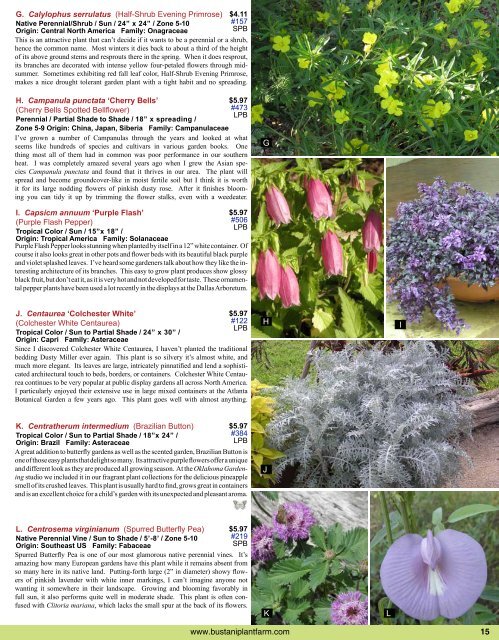Download Catalog - Bustani Plant Farm
Download Catalog - Bustani Plant Farm
Download Catalog - Bustani Plant Farm
You also want an ePaper? Increase the reach of your titles
YUMPU automatically turns print PDFs into web optimized ePapers that Google loves.
G. Calylophus serrulatus (Half-Shrub Evening Primrose)<br />
Native Perennial/Shrub / Sun / 24” x 24” / Zone 5-10<br />
Origin: Central North America Family: Onagraceae<br />
$4.11<br />
#157<br />
SPB<br />
This is an attractive plant that can’t decide if it wants to be a perennial or a shrub,<br />
hence the common name. Most winters it dies back to about a third of the height<br />
of its above ground stems and resprouts there in the spring. When it does resprout,<br />
its branches are decorated with intense yellow four-petaled flowers through midsummer.<br />
Sometimes exhibiting red fall leaf color, Half-Shrub Evening Primrose,<br />
makes a nice drought tolerant garden plant with a tight habit and no spreading.<br />
H. Campanula punctata ‘Cherry Bells’<br />
$5.97<br />
(Cherry Bells Spotted Bellflower)<br />
#473<br />
LPB<br />
Perennial / Partial Shade to Shade / 18” x spreading /<br />
Zone 5-9 Origin: China, Japan, Siberia Family: Campanulaceae<br />
I’ve grown a number of Campanulas through the years and looked at what<br />
seems like hundreds of species and cultivars in various garden books. One<br />
thing most all of them had in common was poor performance in our southern<br />
heat. I was completely amazed several years ago when I grew the Asian species<br />
Campanula punctata and found that it thrives in our area. The plant will<br />
spread and become groundcover-like in moist fertile soil but I think it is worth<br />
it for its large nodding flowers of pinkish dusty rose. After it finishes blooming<br />
you can tidy it up by trimming the flower stalks, even with a weedeater.<br />
I. Capsicm annuum ‘Purple Flash’<br />
(Purple Flash Pepper)<br />
Tropical Color / Sun / 15”x 18” /<br />
Origin: Tropical America Family: Solanaceae<br />
Purple Flash Pepper looks stunning when planted by itself in a 12” white container. Of<br />
course it also looks great in other pots and flower beds with its beautiful black purple<br />
and violet splashed leaves. I’ve heard some gardeners talk about how they like the interesting<br />
architecture of its branches. This easy to grow plant produces show glossy<br />
black fruit, but don’t eat it, as it is very hot and not developed for taste. These ornamental<br />
pepper plants have been used a lot recently in the displays at the Dallas Arboretum.<br />
J. Centaurea ‘Colchester White’<br />
(Colchester White Centaurea)<br />
Tropical Color / Sun to Partial Shade / 24” x 30” /<br />
Origin: Capri Family: Asteraceae<br />
$5.97<br />
#506<br />
LPB<br />
Since I discovered Colchester White Centaurea, I haven’t planted the traditional<br />
bedding Dusty Miller ever again. This plant is so silvery it’s almost white, and<br />
much more elegant. Its leaves are large, intricately pinnatified and lend a sophisticated<br />
architectural touch to beds, borders, or containers. Colchester White Centaurea<br />
continues to be very popular at public display gardens all across North America.<br />
I particularly enjoyed their extensive use in large mixed containers at the Atlanta<br />
Botanical Garden a few years ago. This plant goes well with almost anything.<br />
K. Centratherum intermedium (Brazilian Button)<br />
Tropical Color / Sun to Partial Shade / 18”x 24” /<br />
Origin: Brazil Family: Asteraceae<br />
$5.97<br />
#122<br />
LPB<br />
A great addition to butterfly gardens as well as the scented garden, Brazilian Button is<br />
one of those easy plants that delight so many. Its attractive purple flowers offer a unique<br />
and different look as they are produced all growing season. At the Oklahoma Gardening<br />
studio we included it in our fragrant plant collections for the delicious pineapple<br />
smell of its crushed leaves. This plant is usually hard to find, grows great in containers<br />
and is an excellent choice for a child’s garden with its unexpected and pleasant aroma.<br />
L. Centrosema virginianum (Spurred Butterfly Pea)<br />
Native Perennial Vine / Sun to Shade / 5’-8’ / Zone 5-10<br />
Origin: Southeast US Family: Fabaceae<br />
$5.97<br />
#384<br />
LPB<br />
$5.97<br />
#219<br />
SPB<br />
Spurred Butterfly Pea is one of our most glamorous native perennial vines. It’s<br />
amazing how many European gardens have this plant while it remains absent from<br />
so many here in its native land. Putting-forth large (2” in diameter) showy flowers<br />
of pinkish lavender with white inner markings, I can’t imagine anyone not<br />
wanting it somewhere in their landscape. Growing and blooming favorably in<br />
full sun, it also performs quite well in moderate shade. This plant is often confused<br />
with Clitoria mariana, which lacks the small spur at the back of its flowers.<br />
G<br />
H<br />
J<br />
K<br />
www.bustaniplantfarm.com 15<br />
L<br />
I


